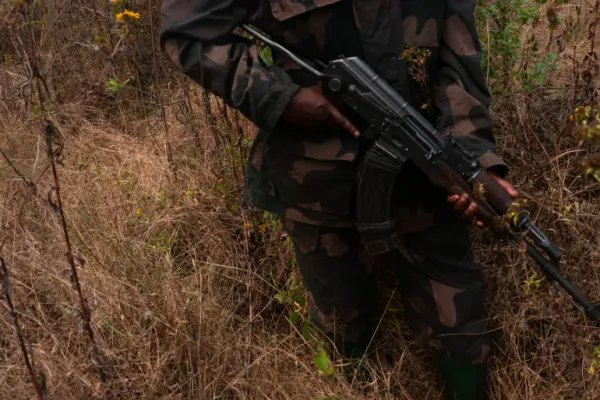In Summary
- Female fighters in eastern DRC join local militias to combat M23 rebels.
- The Wazalendo, a coalition of self-defense forces, is at the forefront of the conflict.
- Women like Byamwungu face harsh realities but continue to fight for survival and peace.
- The Congolese government considers integrating these militias into the national army.
Goma, Democratic Republic of the Congo – Marie Byamwungu, a 20-year-old fighter whose real name is withheld for security reasons, adjusts the oversized sleeves of her military uniform, which hangs loosely on her slight frame. Despite her youthful appearance, her eyes reflect the hardened resolve of someone who has faced fierce battles against the M23 rebels, a group currently engaged in an insurgency in eastern Democratic Republic of the Congo (DRC).
"I’ve seen heavy fighting, but I am proud. I can still go to fight," Byamwungu says with a wry smile as she sits at a paramilitary base, just three kilometers north of Goma, close to the front lines. Around her, young men with assault rifles casually lounge in the shade, embodying the defiant spirit of the Wazalendo, or “patriots” in Kiswahili – a coalition of local self-defense forces fighting to protect their communities from M23 attacks.
Originally formed by former soldiers who mutinied from the Congolese army in 2012, M23 resurfaced in early 2022, reigniting violence and displacing around 1.7 million people. These internally displaced persons now live in precarious conditions, often in makeshift shelters on the outskirts of cities in North Kivu province. The conflict has drawn accusations from the United Nations and the United States, who allege that M23 is supported by Rwanda and Uganda – claims both countries deny.
In response to the growing threat, Congolese President Felix Tshisekedi urged young people to join the fight against M23, either by enlisting in the Armed Forces of the Democratic Republic of the Congo (FARDC) or by forming their own vigilante groups. Many heeded the call, leading to a September 2023 government decree that legalized the integration of militias like the Wazalendo into the national army.
The Wazalendo coalition, which includes newly formed rebel units and long-established fighters, now plays a crucial role in the struggle against M23. They often lead the charge into battle, with FARDC forces following behind. However, this collaboration has raised concerns, with some experts arguing that it gives these militias free rein to operate with impunity.
Women on the Front Lines
Among the Wazalendo are women like Byamwungu, who joined the fight to escape economic hardship and seek protection, or because they felt they had no other choice. Byamwungu’s journey into the militia began after conflict uprooted her family, forcing them to flee their village and seek refuge in a displacement camp near Goma. The dire conditions in the camp, including starvation and the constant threat of violence, drove her to join the Union of Forces for the Patriotic Defence of Congo (UFPDC), a Wazalendo affiliate.
Despite her low-ranking position, which puts her at high risk of death in combat, Byamwungu has adapted to her new life, learning to shoot and taking on responsibilities such as cleaning the base and cooking for male fighters. Although she misses her parents, who have since returned to their village, she remains committed to the cause, believing that she has found a new family among the Wazalendo.
Uncertain Alliances and the Future
The Wazalendo’s ranks are filled with young people eager to defend their homeland. General Mbokani Kimanuka, who founded the UFPDC during the first M23 war in 2012, emphasizes the support they receive from local communities, which provide them with food and other necessities. The fighters’ deep connection to the region, coupled with prayers to both God and their ancestors, offers them a sense of protection and purpose.
However, the integration of militias like the Wazalendo into the national army is not without controversy. The Congolese government has indicated plans to incorporate these fighters into a reserve brigade, but experts warn that this strategy could backfire, as it has in the past. The risk of dissatisfaction and further rebellion looms, threatening to perpetuate the cycle of conflict.
For now, the women of the Wazalendo remain focused on the fight. Byamwungu and her comrades hope for peace but are prepared to continue their struggle as long as necessary. Their stories reflect the harsh realities of life in eastern DRC, where survival often means picking up a gun and joining the battle.


Related News
Top 10 African Nations with the most significant political unrest in 2025
Mar 25, 2025
Top 10 African Countries with the Most Helicopters in Early 2025: A Comparison with 2024
Jan 28, 2025
Top 10 African Nations With the Most U.S. Military Presence and the Possible Impacts of Trump's Administration
Jan 23, 2025